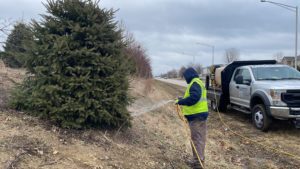Evergreens, like boxwoods, arborvitaes, and junipers, are susceptible to winter burnout. This occurs during particularly dry winter months when the roots can no longer pull water from the soil to feed the plant. Instead, they rely on the moisture that is stored in their leaves, which causes evaporation. When evaporation occurs, the plant’s leaves or needles turn brown or yellow. In most cases, they won’t recover come spring.
How to Prevent Winter Burnout

We can apply a biodegradable anti-desiccant to evergreens to help avoid winter burnout. The spray forms a wax layer, which helps to hold in the plant’s moisture during the harsh winters protecting it from burnout. The anti-desiccant spray then washes off by spring.
Another tip is to give your evergreens a deep and thorough watering before the ground freezes. This will help provide the plant with a boost of hydration before winter sets in.
Using Burlap and Tarps
Plastic wrapping or tarps are very harmful to plants as they don’t allow the tree or shrub to breathe. Burlap can be used to protect the plant from wind damage but should not be applied directly to the plant. The burlap material rubbing against the branches throughout the windy winter months can cause even more damage. Instead, you can create a barrier to the wind by attaching the burlap to stakes in the ground in a pattern that shields the plant but still gives it room to move and breathe.
Have additional questions about protecting your trees and shrubs this winter? Contact us for more information.

